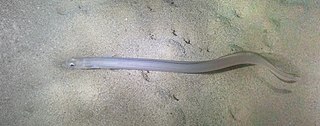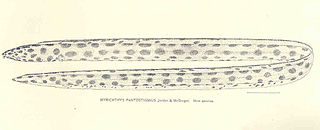
Callechelys is a genus of eels in the snake eel family Ophichthidae. It currently contains the following fifteen species:

The bandtooth conger, also known as the Baleares conger or the Balearic conger, is an eel in the family Congridae. It was described by François Étienne Delaroche in 1809, originally under the genus Muraena. It is a subtropical, marine eel which is known from the western and eastern Atlantic and the western Indian Ocean, including North Carolina, United States; the northern Gulf of Mexico, northern South America, Canada, Portugal, Angola, the Mediterranean, and the Red Sea. It inhabits reefs and littoral shelves, and burrows into sand and mud. It dwells at a depth range of 1–732 meters (3–2,402 ft), but most frequently between 20–100 m (66–328 ft). Males can reach a maximum total length (TL) of 35 centimetres, but more commonly reach a TL of 25 centimetres (9.8 in)
Callechelys bilinearis, the twostripe snake eel, is an eel in the family Ophichthidae. It was described by Robert H. Kanazawa in 1952. It is a marine, tropical eel which is known from the western and southeastern Atlantic Ocean, including Bermuda, the West Indies, Lesser Antilles, St. Helena Island and Ascension Island. It dwells at a depth range of 0 to 22 metres, most often at around 0 to 5 metres. Males can reach a maximum total length of 172.4 centimetres (67.9 in).
Callechelys catostoma, the black-striped snake eel or dark band snake eel,) is an eel in the family Ophichthidae. It was described by Johann Gottlob Theaenus Schneider and Johann Reinhold Forster in 1801. It is a tropical, marine eel which is known from the Indo-Pacific, including the Red Sea, East Africa, the Society Islands, the Ryukyu Islands, and Lord Howe Island. It dwells at a depth range of 1–32 metres, and inhabits reefs. It burrows into loose gravel and sand. Males can reach a maximum total length of 85 centimetres (33 in).
Callechelys cliffi, the sandy ridgefin eel, is an eel in the family Ophichthidae. It was described by James Erwin Böhlke and John Carmon Briggs in 1954. It is a marine, tropical eel which is known from the eastern central Pacific Ocean, including Mexico and Panama. It dwells at a depth range of 0 to 30 metres, and inhabits sand sediments. Males can reach a maximum standard length of 45.5 centimetres (17.9 in).
Callechelys eristigma, the spotted ridgefin eel, is an eel in the family Ophichthidae. It was described by John E. McCosker and Richard Heinrich Rosenblatt in 1972. It is a marine, tropical eel which is known from the eastern central Pacific Ocean, including Costa Rica, Mexico, and Panama. It dwells at a depth range of 5 to 25 metres, and inhabits benthic sediments of rock and sand. Males can reach a maximum standard length of 113 centimetres (44 in).
Callechelys galapagensis, the Galapagos ridgefin eel, is an eel in the family Ophichthidae. It was described by John E. McCosker and Richard Heinrich Rosenblatt in 1972. It is a tropical, marine eel which is known from four specimens collected from the Galapagos Islands, in the southeastern Pacific Ocean. It inhabits coral, sand and rock.
Callechelys leucoptera is an eel in the family Ophichthidae. It was described by Jean Cadenat in 1954. It is a tropical, marine eel which is known from the eastern Atlantic Ocean, including Senegal to Côte d'Ivoire. It is known to dwell at a depth of 45 metres. It inhabits shallow waters where it forms burrows in the sand, which are sometimes exposed during low tide. Males can reach a maximum total length of 73 centimetres, but more commonly reach a TL of 50 centimetres.

Callechelys lutea, the freckled snake eel or yellow-spotted snake eel, is an eel in the family Ophichthidae. It was described by John Otterbein Snyder in 1904.
Callechelys papulosa, the blistered snake eel, is an eel in the family Ophichthidae. It was described by John E. McCosker in 1998. It is a tropical, marine eel which is known from Papua New Guinea, in the western central Pacific Ocean. It is known to dwell at a depth of 10 metres, and to inhabit regions of sand and grass. Males can reach a maximum total length of 55.1 centimetres.
Callechelys springeri, the ridgefin eel, is an eel in the family Ophichthidae. It was described by Isaac Ginsburg in 1951, originally under the genus Gordiichthys. It is a marine, tropical eel which is known from the eastern Gulf of Mexico, in the western Atlantic Ocean. It dwells at a depth range of 22 to 36 metres. Males can reach a maximum total length of 80.1 centimeters (31.5 in).
The Horsehair eel is an eel in the family Ophichthidae. It was described by David Starr Jordan and Bradley Moore Davis in 1891. It is a marine, tropical eel which is known from the western central Atlantic Ocean, including Florida, USA, the Gulf of Mexico and Puerto Rico. It dwells at a depth range of 90 to 200 meters, and inhabits sand and mud substrates. Males can reach a maximum total length of 76 centimeters (30 in).
The smiling snake eel is an eel in the family Ophichthidae. It was described by David Starr Jordan and Charles Henry Gilbert in 1882, originally under the genus Apterichthys. It is a marine, tropical eel which is known from the eastern central and southeastern Pacific Ocean, including Colombia, Costa Rica, Panama, Ecuador, and Mexico. It dwells at a maximum depth of 30 metres (98 ft), and inhabits sediments of sand. Males can reach a maximum total length of 41 centimetres (16 in).

The Clarion snake eel is an eel in the family Ophichthidae. It was described by David Starr Jordan and Ernest Alexander McGregor in 1898. It is a tropical, marine eel which is known from Mexico, in the eastern central Pacific Ocean. It inhabits shallow waters - at a maximum depth of 20 metres - and is found around rocks and sand. Males can reach a maximum total length of 49.4 centimetres.
Myrichthys xysturus is an eel in the family Ophichthidae. It was described by David Starr Jordan and Charles Henry Gilbert in 1882, originally under the genus Ophichthys. It is a marine, tropical eel which is known from the eastern central Pacific Ocean, including the Gulf of California; Baja California Sur, Mexico; and the Galapagos Islands.

The Evermann's snake eel is an eel in the family Ophichthidae. It was described by David Starr Jordan and Robert Earl Richardson in 1908. It is a marine, tropical eel which is known from the western Pacific Ocean. It inhabits inshore soft bottoms.
The wrinkled snake eel is an eel in the family Ophichthidae. It was described by David Starr Jordan and Charles Harvey Bollman in 1890. It is a marine, tropical eel which is known from the eastern central and southeastern Pacific Ocean, including the Galapagos Islands and the Cocos Islands. It is also speculated to occur in Malpelo Island. It is known to dwell at a depth of 200 metres (660 ft), and inhabits sediments of sand and rubble. Males can reach a maximum total length of 68 centimetres (27 in).
The yellow snake eel is an eel in the family Ophichthidae. It was described by David Starr Jordan and Charles Henry Gilbert in 1882. It is a marine, subtropical eel known from the eastern central and southeastern Pacific Ocean, including Chile, Costa Rica, Colombia, Ecuador, Guatemala, El Salvador, Honduras, Nicaragua, Mexico, Panama, Peru, and the United States. It dwells at a depth range of 1 to 110 m, and forms burrows in rocky and sandy regions. Males can reach a maximum total length of 98 cm (39 in), but more commonly reach a length of 50 cm (20 in).

The Marble-toothed snake-eel is an eel in the family Ophichthidae. It was described by Charles Henry Gilbert in 1898. It is a marine, tropical eel which is known from the eastern central and southeastern Pacific Ocean, including Costa Rica, Colombia, Panama and Ecuador. It dwells in shallow waters at a maximum depth of 10 metres (33 ft), and inhabits sand and mud sediments and mangroves. Males can reach a maximum total length of 68 centimetres (27 in).

The Galapagos snake eel is an eel in the family Ophichthidae. It was described by David Starr Jordan and Charles Harvey Bollman in 1890. It is a marine, tropical eel which is known from the eastern central and southeastern Pacific Ocean, including Colombia, the Gulf of California, Costa Rica, the Galapagos Islands in Ecuador, and Clarion Island in the Revillagigedo Archipelago in Mexico. It dwells at a depth range of 3 to 80 metres, and inhabits reefs, preferring to live in areas bearing a mixture of boulders, gravel and sand. Males can reach a maximum total length of 71 centimetres (28 in).







